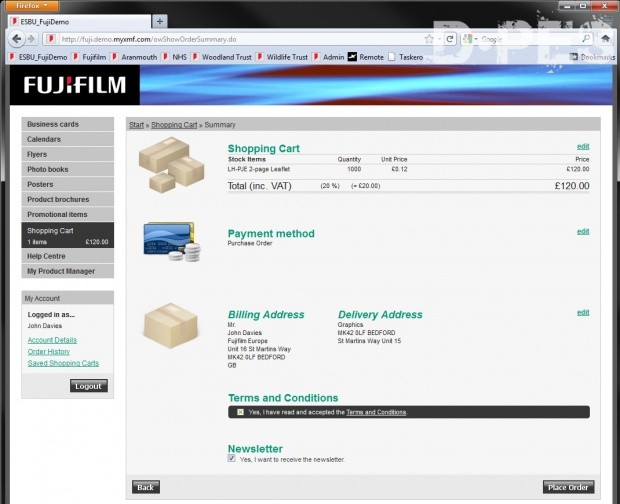When Fujifilm previewed its XMF workflow system at Ipex a couple of years ago, it was one of the first Adobe PDF Print Engine-based (APPE) workflow systems to reach the market. Now Fujifilm has introduced XMF Print Centre, and is once again in the vanguard of workflow management. XMP Print Centre is a cloud-based system, hosted and managed by Fujifilm using server farms in Germany, the USA and Japan to deliver web-to-print services. As cloud owner, Fujifilm is responsible for all hardware and software, data processing and management.
XMF Print Centre is based on technology derived from Fujifilm's web-to-print photo business, a cloud-based service for business and consumer photo processing. Fujifilm is using this idea to provide printers with a web-to-print system based on XMF. At heart, XMF is a JDF database so it has been designed from the ground up for interconnectivity. Because XMF is an implementation of APPE RIP technology, it can process native PDF 1.6 files in the RIP so there is no need to flatten files with transparencies or to translate them into PostScript before output. This makes file processing quicker and more efficient. XMF also incorporates Fujifilm's RGB-based colour management and Fujifilm screening, both Cores and Taffeta, all of which are proven in the field. XMF also has direct connections to both Adobe Creative Suite and Quark XPress so PDF creation is seamless. XMF is designed so that all information relating to a job is accessible at all times. This expands the remit of a workflow system and avoids the blind spots of Fuji's previous workflow systems, Celebrant and Rampage. XMF builds on the experience gained with these technologies, so that the workflow system does not limit an operator's view to selected information and content depending on a job's production status.

XMF Print Centre can be used for commercial and wide-format print companies
Perhaps more interesting than the impressive features of XMF, the use of XML and JDF connectivity ensures that it can additionally host multiple business tools. The scope to incorporate MIS and financial management tools into the workflow make for considerable extensibility and flexibility. And XMF is scalable so it can grow with the production volume. A large number of companies have already embraced XMF. Jade, based in Leeds, Yorkshire invested in it, and comments: "It allows us to process PDF files quickly and efficiently, saving us a great deal of time in pre-press. It also enables us to output to a number of different devices, and provides the ability to offer remote proofing to our customers via XMF Remote. Also, it is excellent in terms of its built-in colour management functionality."
XMF is Windows server-based, supporting Mac and PC clients, and supports conventional computer-to-plate (CTP) and digital printing workflows. With its entrenched position in platesetting and the new Jetpress digital ink-jet press nearing completion, Fujifilm has an interest in conventional, digital and hybrid output management. XMF makes it simple, for example, to re-impose flats from four-up to eight-up output, or to reprocess a data file for output to a digital press instead of to plate. Jobs can be sent to multiple engines, reprocessed according to the constraints and requirements of the different output streams. The file remains totally independent until the output decisions are made, so XMF can support distributed processing and output to multiple destinations, for instance via the internet.
XMF Print Centre adds a web-to-print dimension to the technology, including the means for a printing company to set up their own e-commerce web portals using cloud-sourced tools. The websites can be tailored to the requirements of individual or multiple customers, with full support for a wide variety of static and variable data printed products. The customisable web shop allows printers to adapt their branding for particular target markets or individual clients, and is suitable for all print business from commercial to wide-format. XMF Print Centre is only available via the Fujifilm cloud.
Internet awareness was one of the most glaring omissions in XMF when the technology was first introduced. Early versions of XMF lacked support for web-to-print workflows, file sharing over the internet and distributed system support. Some of these shortcomings were fixed in subsequent versions, but with XMF Print Centre, Fujifilm is moving even more robustly to support internet-driven business models. We can expect more cloud developments from Fujifilm in the next few months.